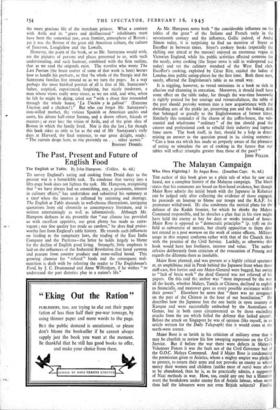The Past, Present and Future of English Food
The English at Table. By John Hampson. (Collins. 4s. 6d.) To survey England's eating and cooking from Druid days to the present war is a formidable task. To condense that survey into a fifty-page book does not lighten the task. Mr. Hampson, recognising that "we have always had an astonishing, nay, a passionate, interest in culinary affairs," has undertaken and submitted his summary at a timd when the interest is inflamed by rationing and shortage. The English at Table abounds in well-chosen illustrations, intriguing quotations from old chronicle to contemporary literature, and is written entertainingly as well as informatively. Although Mr. Hampson deduces in bis preamble- that "our climate has provided us with excellent appetites, our great plenty has made us extra- vagant ; our fine quality has made us careless," he does find praise- worthy fare from England's table history. He records such influences on feeding as the sumptuary laws, the trading of the East India Company and the Puritans—the latter he holds largely to blame for the decline of English good living. Strangely, little emphasis is laid on the influences of the Industrial Revolution that lured yeoman and peasant from country produce and stone-milled bread. This growing clamour for " refined " foods and the consequent mal- nutrition is dealt with by referring the reader to The Englishman's Food, by J. C. Drummond and Anne Wilbraham, if he wishes " to understand the part dietetics play in a nation's life." As Mr. Hatripson notes both " the considerable influence on the tables of the great " of the Italians and French early in the seventeenth century and the influence, Gallic indeed, of Andre Simon today, it is surprising to find no mention of Soyer or Escoffier in between times. Soyer's cookery books (especially the
shilling one aimed at the masses) enjoyed an enormous vogue in Victorian England, while his public activities affected canteens for the needy, army cooking (the Soyer stove is still in widespread use today) and set the culinary standard of the West End club. Escoffier's cooking, exploited by Cesar Ritz, cajoled the ladies of London into public eating-places for the first time. Both these men, surely, affected the Englishman's table in no small way.
It is niggling, however, to reveal omissions in a book so rich in allusion and charming in execution. Moreover, it should itself have some effect on the table today, for though the war-time housewife is rightly praised for her courage and resourcefulness, the table of the past should provoke women into a new acquaintance with the dwindling arts of the pickle jar, preserving pan and the baking dish that belonged so grandly to the Englishwomen of former times, Similarly this reminder of the charm of the coffee-house, the sub- stantial and wholesome " ordinary " of the inn should goad the caterer and professional cook to rebuild their industry and capture fame anew. The book itself, in fact, should be a help in deter- mining an answer to the question posed in its closing sentence : " Can a lean era which has made us properly aware of the pleasures of eating so stimulate the art of cooking in the future that our tables will reflect triumphs greater than those of the past? "
JOHN FULLER.


























 Previous page
Previous page